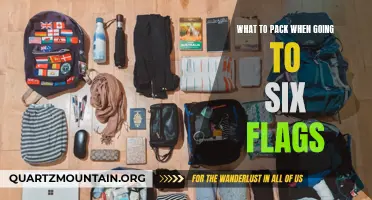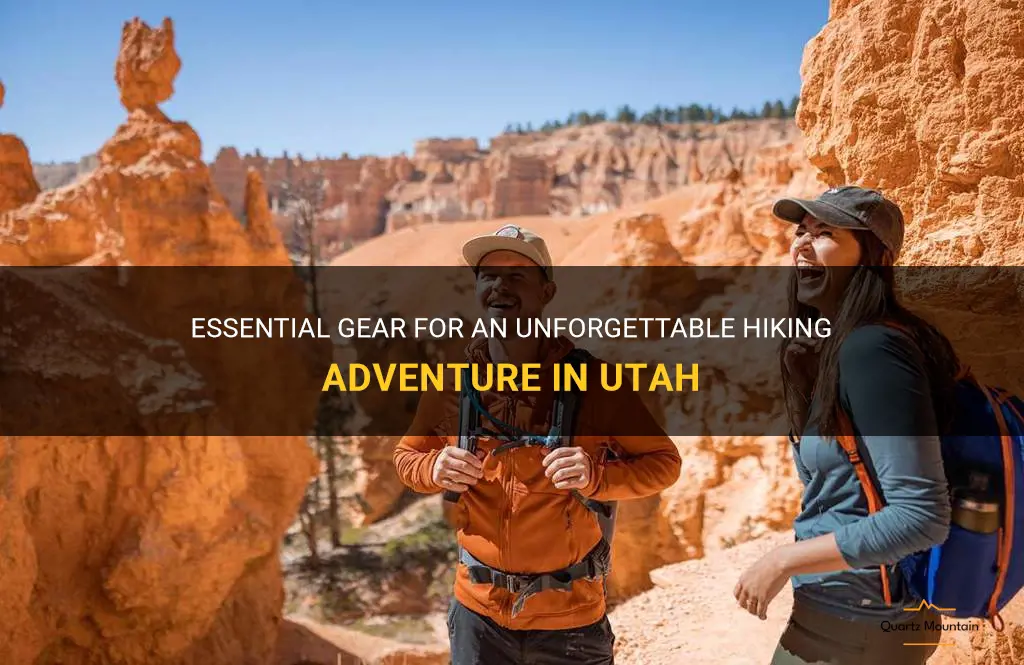
Utah is a hiker's paradise, with its diverse landscapes and breathtaking views. Whether you're planning a day hike or a multi-day backpacking adventure, having the right gear can make all the difference in ensuring a safe and unforgettable experience. From sturdy footwear to a reliable hiking backpack, this guide will cover all the essential gear you need to have for a hiking adventure in Utah. So grab your boots and get ready to explore the stunning trails that await you in the great outdoors of Utah.
What You'll Learn
- What are the essential items to pack for hiking in Utah?
- What kind of clothing and footwear should I bring for hiking in Utah?
- Are there any specific items or gear that are unique to hiking in Utah?
- How should I prepare for changing weather conditions when hiking in Utah?
- Are there any specific safety considerations or items I should include in my hiking pack for Utah?

What are the essential items to pack for hiking in Utah?
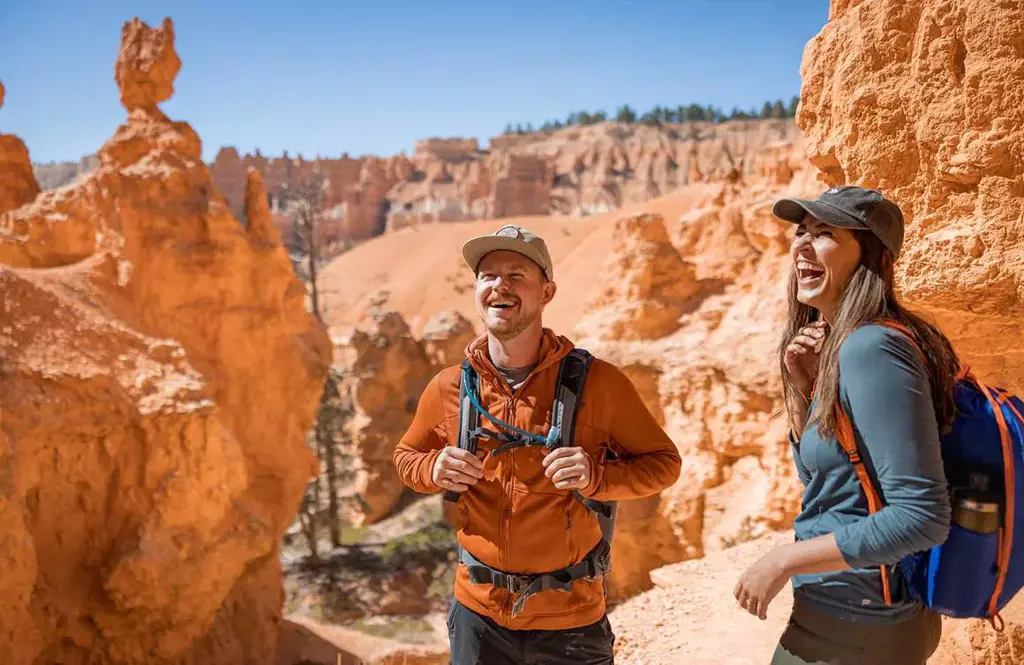
When it comes to hiking in Utah, it's important to pack the right gear to ensure a safe and enjoyable adventure. Utah's rugged and diverse terrain can present challenges, so being prepared is essential. Here's a list of essential items to pack for hiking in Utah:
- Proper footwear: Invest in a good pair of hiking boots that provide ankle support and have a sturdy sole for traction. Utah's trails can be rocky and uneven, so having the right footwear is crucial to prevent injuries.
- Hydration system: Utah's arid climate means staying hydrated is crucial. Pack a hydration bladder or water bottles to ensure you have enough water for the duration of your hike. It's recommended to drink at least one liter of water per hour while hiking in Utah.
- Navigation tools: Utah's vast wilderness can be easy to get lost in, so bring a GPS device or a map and compass to help navigate. Familiarize yourself with the trail beforehand and be sure to have a backup plan in case of emergencies.
- Sun protection: Utah's high elevation and abundant sunshine mean you'll be exposed to strong UV rays. Pack sunscreen with a high SPF, a hat, and sunglasses to protect your skin and eyes from the sun's harmful effects.
- Layered clothing: Utah's weather can be unpredictable, so it's important to pack layers. Start with a moisture-wicking base layer, add a insulating layer, and top it off with a waterproof and breathable outer shell. This will allow you to adjust your clothing according to the temperature and conditions.
- First aid kit: Accidents happen, so it's essential to have a basic first aid kit handy. Include band-aids, adhesive tape, gauze pads, pain relievers, antiseptic wipes, and any personal medications you may need.
- Snacks and food: Pack high-energy snacks like trail mix, granola bars, and dried fruit to keep your energy levels up during your hike. If you'll be out for a longer period of time, bring a lightweight meal like a sandwich or energy bars.
- Emergency shelter: In the event of an unexpected storm or injury, having a lightweight emergency shelter such as a tarp or bivy sack is essential. It will protect you from the elements and keep you warm until help arrives.
- Headlamp or flashlight: Even if you plan to finish your hike before dark, accidents or delays can happen. Always carry a headlamp or flashlight as a backup light source in case you find yourself stuck on the trail after sunset.
- Trekking poles: Utah's trails can be steep and challenging, so having trekking poles can provide stability and reduce stress on your knees and joints. They can also help with balance on uneven terrain.
Remember, these are just the essentials. Depending on the length and difficulty of your hike, you may need to pack additional gear such as a tent, sleeping bag, or cooking equipment. It's also important to let someone know your hiking plans and expected return time. Stay safe, stay prepared, and enjoy the beauty of Utah's stunning landscapes.
Essential Gear for Your Bowhunting Day Pack
You may want to see also

What kind of clothing and footwear should I bring for hiking in Utah?

Utah is a popular destination for hiking enthusiasts due to its stunning landscapes and diverse terrain. Whether you're a beginner or an experienced hiker, it's important to have the right clothing and footwear to ensure a safe and comfortable experience on the trails. In this article, we will discuss the key items you should bring for hiking in Utah.
Hiking Boots:
Investing in a good pair of hiking boots is crucial for tackling Utah's rugged and rocky terrain. Look for boots that provide ankle support, have sturdy soles with good traction, and are waterproof or at least water-resistant. They should fit well and be comfortable to wear for long periods of time to prevent blisters and foot pain.
Moisture-Wicking Clothing:
Utah's climate can be dry and hot, especially during the summer months. It's important to wear moisture-wicking clothing to keep yourself cool and dry during strenuous hikes. Look for lightweight and breathable shirts, pants, and shorts made from materials such as nylon or polyester. Avoid cotton as it retains moisture and can lead to discomfort and chafing.
Layering:
Utah's weather can be unpredictable, with temperature fluctuations throughout the day. It's important to dress in layers to adapt to changing conditions. Start with a moisture-wicking base layer, add a mid-layer for insulation, and top it off with a waterproof and breathable outer layer to protect yourself from rain or wind.
Hat and Sunglasses:
Utah's high elevation means strong sun exposure, which can lead to sunburn and eye strain. Protect yourself by wearing a wide-brimmed hat that shades your face, neck, and ears. Additionally, don't forget to bring sunglasses with UV protection to shield your eyes from harmful rays and glare.
Socks:
Investing in moisture-wicking and cushioned hiking socks is essential for preventing blisters and providing comfort during long hikes. Look for socks made from merino wool or synthetic fibers that offer breathability, moisture management, and padding in key areas such as the heels and toes.
Backpack:
A comfortable and well-fitted backpack is necessary for carrying essential items such as water, snacks, sunscreen, a map, a compass, a first aid kit, and extra clothing layers. Look for a backpack with adjustable straps and multiple compartments to distribute weight evenly and keep your belongings organized.
Gaiters:
Gaiters are handy accessories that go over your boots to protect your lower legs from debris, water, and snow. They are especially useful for hikes in Utah's desert regions or during the winter months when trails may be muddy or snow-covered.
Remember, it's important to always check the weather forecast before heading out on a hike in Utah. This will help you determine the appropriate clothing and footwear for the current conditions. Additionally, consult trail maps and guides to prepare for the specific challenges and requirements of the hike you plan to undertake.
By following these recommendations and wearing the appropriate clothing and footwear, you can enjoy a safe and comfortable hiking experience in Utah's beautiful landscapes. Happy hiking!
Essential Items to Pack for a Memorable Trip to Martinique
You may want to see also

Are there any specific items or gear that are unique to hiking in Utah?

Hiking in Utah is a unique and rewarding experience. The state offers a diverse range of landscapes, from stunning red rock formations to towering mountains and lush forests. With such diverse terrains and climates, there are certain items and gear that are particularly useful and even unique to hiking in Utah.
One essential piece of gear for hiking in Utah is proper footwear. The terrain in Utah can be quite rugged, with rocky and uneven surfaces. A pair of sturdy hiking boots with good ankle support is crucial for navigating these trails safely. Additionally, Utah is known for its dry and hot desert climate, so it is important to choose footwear that is breathable and can withstand high temperatures.
Another important item to bring on a hike in Utah is a good hat. The sun can be intense in the desert regions of the state, and a hat with a wide brim offers protection for your face and neck. Additionally, a hat can help keep you cool by providing shade and preventing overheating.
A hydration system is also essential when hiking in Utah. The dry climate and high temperatures can quickly lead to dehydration, so it is important to carry enough water to stay hydrated. Many hikers in Utah choose to use a hydration bladder or water reservoir, which can be easily carried in a backpack and allows for easy access to water while on the trail.
In addition to these essential items, there are also some unique pieces of gear that are particularly useful in Utah. One such item is a pair of hiking poles. Hiking poles can provide extra stability and support when navigating the rocky trails in Utah. They can also help reduce strain on your joints and muscles, making your hike more comfortable and enjoyable.
Another unique piece of gear for hiking in Utah is a lightweight and compact backpacking stove. Utah is home to some stunning backcountry areas, and having a stove allows you to cook meals and enjoy hot beverages while exploring these remote regions. There are many lightweight and fuel-efficient stove options available, making it easy to carry one in your backpack.
Lastly, a good pair of sunglasses is essential when hiking in Utah. The state has an average of over 200 sunny days per year, and the glare from the sun can be intense. Sunglasses with UV protection can help protect your eyes from harmful rays and reduce the risk of eye strain and fatigue while hiking.
In conclusion, there are several items and gear that are particularly useful and even unique to hiking in Utah. These include proper footwear, a good hat, a hydration system, hiking poles, a backpacking stove, and sunglasses. By being prepared with these items, you can enjoy a safe and enjoyable hiking experience in the beautiful landscapes of Utah.
Essential Gear for Hiking in Norway: A Complete Packing Guide
You may want to see also

How should I prepare for changing weather conditions when hiking in Utah?
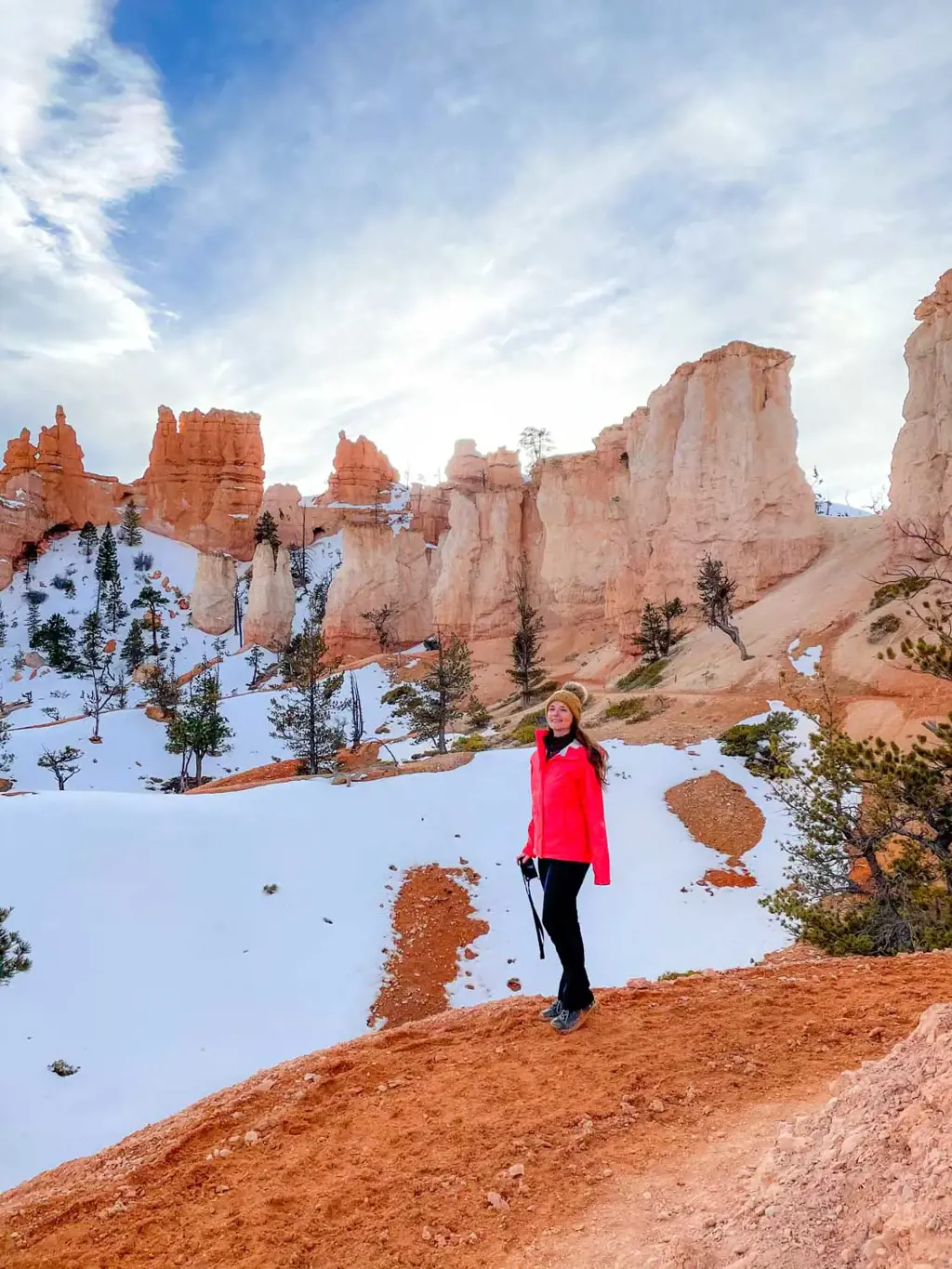
Hiking in Utah offers stunning landscapes and unforgettable experiences, but it also comes with ever-changing weather conditions. The key to a successful hiking trip in Utah is to be prepared for these fluctuating weather patterns. Here are some essential tips to help you prepare for changing weather conditions when hiking in Utah:
- Check the Weather Forecast: Before heading out on your hiking adventure, always check the weather forecast for the area you'll be exploring. Utah's weather can be unpredictable, so it's important to have a general idea of what to expect. Keep in mind that the weather can change rapidly, so be prepared for sudden shifts in conditions.
- Dress in Layers: Layering your clothing is crucial when hiking in Utah. Start with a moisture-wicking base layer that will keep you dry and warm. Add a mid-layer, such as a fleece or down jacket, for insulation. Finally, top it off with a waterproof and windproof outer layer to protect yourself from rain, snow, and strong winds. This layering system allows you to adapt your clothing to changing weather conditions.
- Wear Appropriate Footwear: Invest in a good pair of hiking boots that provide ankle support and have a sturdy sole. Utah's trails can be rocky and uneven, so having the right footwear is essential for stability and comfort. Waterproof boots are preferred, as they will keep your feet dry in wet conditions.
- Carry Essential Gear: Always carry essential gear with you when hiking in Utah. This includes a map and compass or GPS device to help you navigate, a headlamp or flashlight, a first aid kit, a whistle, and a multi-tool. Additionally, pack a waterproof backpack cover to protect your gear from rain or snow.
- Stay Hydrated: Staying hydrated is crucial when hiking in any weather condition. Utah's dry climate can lead to dehydration, even in cooler temperatures. Carry plenty of water with you and make sure to drink regularly, even if you don't feel thirsty. Consider using a hydration bladder or water bottle with a built-in filter to refill from natural water sources, such as streams or lakes.
- Be Aware of Altitude: Many hiking trails in Utah take you to high elevations, where the air is thinner and temperatures are colder. Altitude can affect your body's ability to adjust to changing weather conditions, so it's important to be aware of any signs of altitude sickness. Take it slow, drink plenty of water, and listen to your body. If you experience severe symptoms, such as dizziness, shortness of breath, or severe headaches, descend to a lower elevation immediately.
- Check Trail Conditions: Before hitting the trail, check for any trail closures, warnings, or advisories. Heavy rain or snowfall can make trails muddy and slippery, while thunderstorms can increase the risk of lightning strikes. Stay informed about trail conditions and adjust your plans accordingly.
- Plan for Shelter: In the event of sudden and severe weather conditions, it is crucial to have a plan for shelter. If possible, choose a hiking route that offers natural shelter, such as trees or large boulders. If caught in a thunderstorm, avoid open areas and seek shelter in a low-lying area away from tall objects.
- Stay Updated: Weather conditions can change rapidly, so it's important to stay updated throughout your hike. Check your phone for weather updates or listen to a weather radio if available. If conditions worsen or become dangerous, it's better to turn back and return to safety.
- Share Your Plan: Before heading out on a hike, always let someone know about your plans. Share your itinerary, including the trail you'll be hiking, estimated time of return, and emergency contact information. This way, if you encounter any difficulties or become lost, help can be notified promptly.
By following these tips and being prepared for changing weather conditions, you can make the most of your hiking adventure in Utah. Remember to prioritize safety, stay informed, and respect the power of nature. With proper planning and preparation, you can have a memorable and enjoyable hiking experience in this beautiful state.
Essential Packing List for a Baby on a Disney Cruise
You may want to see also

Are there any specific safety considerations or items I should include in my hiking pack for Utah?
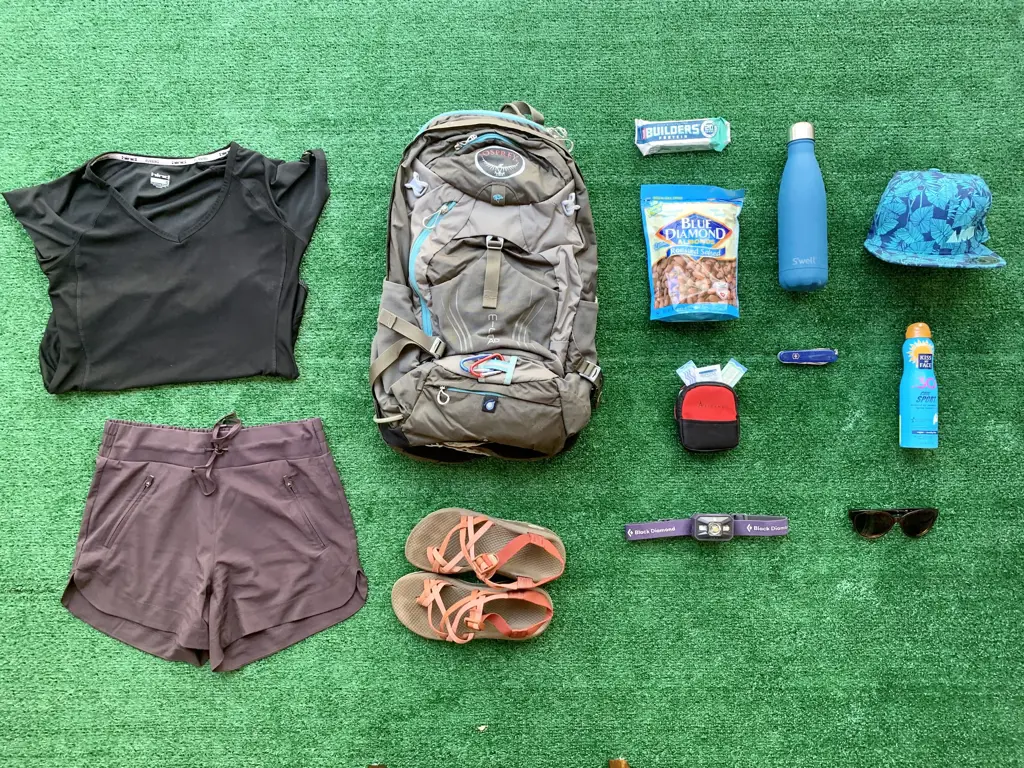
Utah is a hiker's paradise, with its diverse landscapes and breathtaking natural beauty. From the red rock canyons of Zion National Park to the snowy peaks of the Wasatch Mountains, there are countless trails and wilderness areas to explore. However, when embarking on a hiking adventure in Utah, it is important to take certain safety considerations into account and pack the necessary items to ensure a safe and enjoyable experience.
First and foremost, it is crucial to research and plan your hike in advance. Familiarize yourself with the trail you will be hiking, including its length, difficulty level, and any potential hazards or closures. Check the weather forecast for the area and be prepared for sudden changes in weather conditions. Utah's desert climate is known for its hot summers and unpredictable flash floods, so it is essential to be aware of any potential risks.
When it comes to packing your hiking pack for Utah, there are several items that should be included to enhance your safety and comfort. Here are some essential items to consider:
- Map and Compass: Even if you are using a GPS device or smartphone app for navigation, it is always wise to carry a map and compass as a backup. Electronics can fail or run out of battery, so having a reliable source of navigation is crucial.
- Sun Protection: Utah's high altitude and sunny days can lead to intense sun exposure. Pack sunscreen with a high SPF, a wide-brimmed hat, sunglasses with UV protection, and lightweight, breathable clothing that covers your skin.
- Sufficient Water: Staying hydrated while hiking in Utah is of utmost importance. Carry at least two to three liters of water per person, and be mindful of refilling opportunities along the trail. Water sources can be scarce in some areas, so planning ahead is essential.
- Trail Snacks: Pack lightweight, energy-rich snacks such as nuts, dried fruits, granola bars, and energy gels to keep your energy levels up during the hike. It is important to replenish your body with nutrients to prevent exhaustion.
- First Aid Kit: A basic first aid kit is a must-have in any hiking pack. Include items such as band-aids, antiseptic wipes, blister treatment, pain relievers, and any medication you may require.
- Emergency Shelter and Supplies: In case of unexpected events, pack an emergency shelter such as a lightweight tent or bivy sack. Carry a whistle or signaling device, a headlamp or flashlight with spare batteries, and a fire starter in case you need to attract attention or stay warm during the night.
- Proper Footwear: Invest in a good pair of hiking boots or shoes with ankle support and good traction. Utah's trails can be rocky and uneven, so having footwear that minimizes the risk of slips and injuries is crucial.
- Extra Layers: Utah's weather can be unpredictable, with temperature fluctuations between day and night. Pack lightweight, moisture-wicking layers that can be easily added or removed, including a rain jacket, fleece, and thermal base layers.
These are just a few of the essential items to include in your hiking pack when exploring the trails of Utah. Additionally, it is always recommended to hike with a partner or in a group, inform someone about your hiking plans, and take the time to learn basic wilderness first aid and survival skills. By being prepared and taking necessary precautions, you can have a safe and enjoyable hiking experience in the beautiful landscapes of Utah.
Essential Items to Pack for a Hike Inn Adventure
You may want to see also
Frequently asked questions
When preparing for a day hike in Utah, it is important to pack the essentials. These include a sturdy and comfortable pair of hiking shoes or boots, plenty of water, and sunscreen. You should also bring a hat to protect yourself from the sun, a map or GPS device, a first aid kit, and any necessary medication you may need. Additionally, it is a good idea to bring some snacks and a lightweight but warm layer in case the weather changes.
Yes, it is recommended to pack moisture-wicking and quick-drying clothing for hiking in Utah, as the weather can be unpredictable and temperatures can change throughout the day. It is important to dress in layers, so you can easily adjust to fluctuating temperatures. You should also pack a waterproof and breathable rain jacket in case of unexpected rain showers. Don't forget to bring a pair of hiking socks to keep your feet comfortable and blister-free during your hike.
In addition to the basics, there are a few other items you should consider packing for a hike in Utah. These include a backpack to carry all your supplies, a hiking pole or trekking poles for extra stability, and a headlamp or flashlight in case your hike takes longer than expected and you need to navigate in the dark. It is also a good idea to bring a camera to capture the beautiful scenery of Utah. Lastly, don't forget to pack a trash bag to carry out any trash you generate during your hike, as leaving no trace is an important principle of outdoor ethics.







